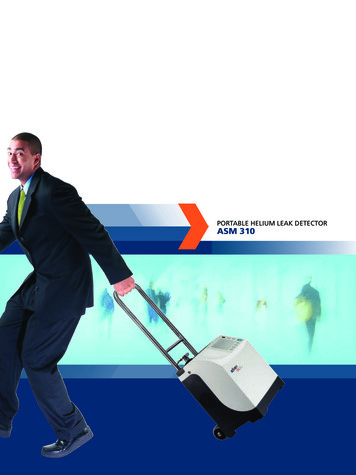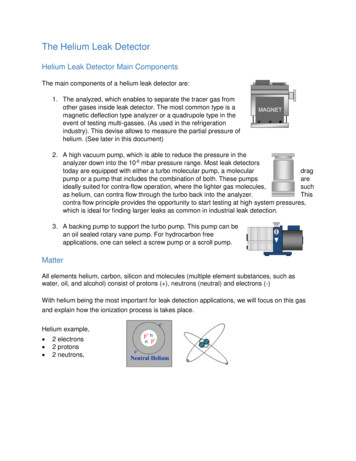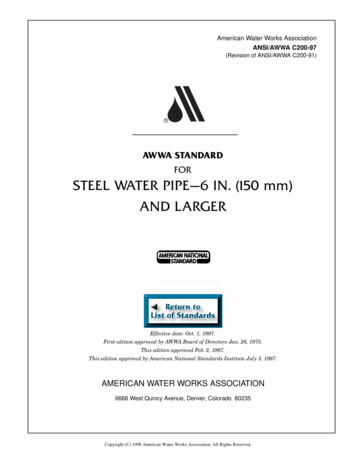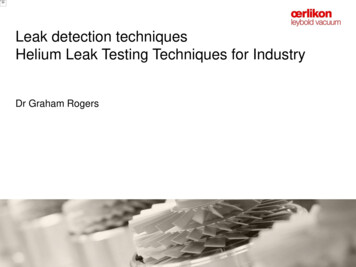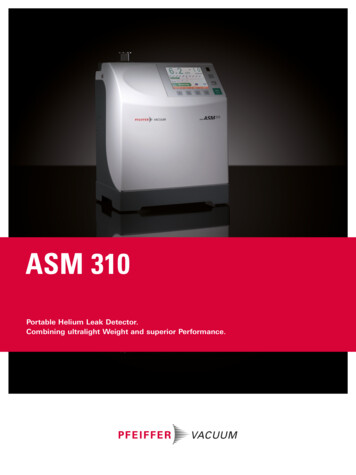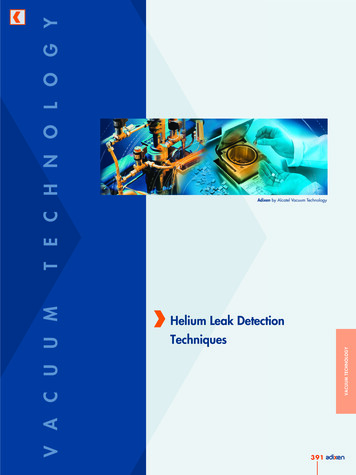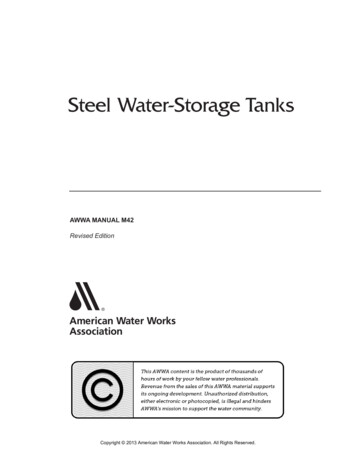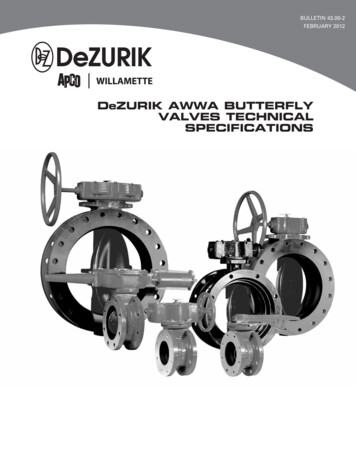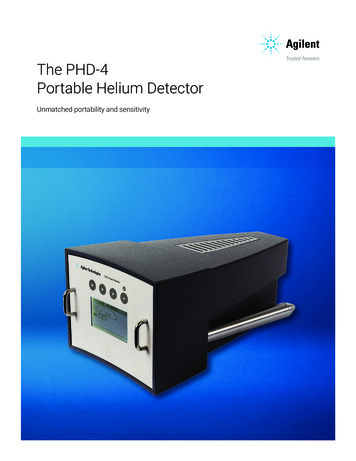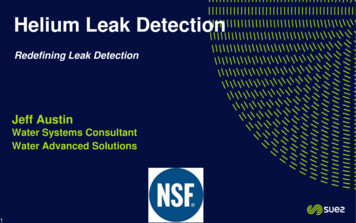
Transcription
Helium Leak Detection Redefining Leak Detection1 May 4th, 2016Jeff AustinWater Systems ConsultantWater Advanced Solutions
Overview Introduction Current Methods of Leak DetectionI. Current NeedsII. Understanding AcousticIII. Data Logging Helium Leak DetectionI.II.Definition of servicePrinciples of the process Application of the TechnologyI.Case Studies Questions2
Introduction:Jeff Austin: Water Systems Consultant since 2011Pacific NorthwestWith Utility Service since 2011CEU Trainer with OAWU and AWWAPNWC 50 Asset Inspections Annually Work with customers to solvemaintenance and water quality issuesthroughout the distribution system
Water Advanced SolutionsUnique TechnologiesAsset Management AMI IcePiggingWasteWaterBiosolidsDryingThe North American leader in Asset Management Over 8000 assets under WAS programsWAS responds by providing customized system Asset Management solutionsthrough: Local water system consultantsRegional water system specialists and service centersTechnical experts in water source, quality, storage, metering & distribution
Water System Maintenance Programs areDesigned to Extend the Useful Life of AssetsCost-effective!5
Overview Introduction Current Methods of Leak DetectionI. Current NeedsII. Understanding AcousticIII. Data Logging Helium Leak DetectionI.II.Definition of servicePrinciples of the process Application of the TechnologyI.Case Studies Questions6
Water Balance
The Investment Bubble AWWA Buried, No LongerConfronting AmericasInfrastructure Challenge 1Trillion Need American Society of CivilEngineers gives drinkingwater systems a D- Grade America’s drinking watersystems face an annualshortfall of at least 11billion to replace agingfacilities2/3rd to 3/4th of InvestedCapitalUSEPA Drinking Water Needs Survey
Pipe Age70 years
Understanding Acoustic LDWater leaks in underground, pressurized pipesmay make many different sounds: “Hiss” or “Whoosh” from pipe vibration and orifice pressure reductiono Often sounds like constant static noiseo Is the only one which is always present for leaks in pipes with 30 psi or higherwater pressure. “Splashing” or “Babbling Brook” sounds from water flowing around thepipe Rapid “beating/thumping” sounds from water spray striking the wall ofthe soil cavity Small “clinking” sounds of stones and pebbles bouncing off the pipe Easier to pickup for leaks in pipes with 30 psi or higherwater pressureOther sounds may or may not be present, and usually theyare not as loud. So, we decide “Is there a leak?”
What Factors Affect These Sounds?Several factors that affect the loudness and the frequencyrange of sounds made by leaks transmitted on the pipes andto the surface: Water pressure in the pipe Pipe material and pipe diameter Soil type and soil compaction Depth of soil over the pipe Surface cover: grass, loose soil, asphalt, concrete slab, etc. External noise: traffic, urban, industrial, RRThe loudness or intensity of the leak sound is directlyproportional to the water pressure inside the pipe(up to a limit):
How Far Do Leak Sounds Travel Metal pipes, particularly iron mains between 6 inches and12 inches, copper services, and steel pipes transmit thesounds of water leaks for hundreds of feet in all directions. Asbestos-cement pipe and PVC pipe do not transmit thesounds nearly as far. Distances transmitted for the sounds of water leaks are afunction of the pipe diameter as well as the pipe material: Typical distance sound Travels for 2 gpm leak at 60 PSI 6 inch Cast Iron Pipe 12 inch AC Pipe 24 inch PVC Pipe600 to 1000 feet300 to 500 feet50 to 100 feet
Data Logging Applications Automatic Meter Reading NRW Flow Data Customer levels of service Network Modeling DMA Data Flow & Pressure Reservoir and Tank Monitoring Water Quality Treatment Plant Monitoring Mains Leakage Data Waste Water Monitoring CSO PRV Sites Storm Drain OverflowIf there is an output we can generally log it !
Other Leak Detection Technologies Smart pigs (Pure, JD7)Acoustic sensors (Pure, Echo, Permalog,SubSurface)Aerial thermography Main Drawbacks: Cost Availability Application constraints Pipe diameterVelocityPressureGeometryLaunch site construction
Overview Introduction Current Methods of Leak DetectionI. Current NeedsII. Understanding AcousticIII. Data Logging Helium Leak DetectionI.II.Definition of servicePrinciples of the process Application of the TechnologyI.Case Studies Questions15
Helium - NSF Standard 60 Drinking WaterTreatment Chemicals Certification Helium certified to 99.999% pureUtility Service Company, Inc.1230 Peachtree Street NortheastSuite 1100Atlanta, GA 30309United States678-235-0281Facility : Madison, NCHeliumTrade DesignationProduct FunctionUtility Service Company - Helium Series AUtility Service Company - Helium Series B
Helium Leak Detection Features In use since 2007 Helium injected into live water mains - no need todepressurize the water system Particularly suited for plastic & large diameter pipes,although suited for any material Can be used in challenging conditions Long runsIntermittent pressuresDifficult to locate leaks Injection can be used to pinpoint leaks for up to 5 days17
Principles of Helium LDHelium gasinjection
Insertion / Injection of HeliumInjection ProcessStandard Injection PointInjection through astandard ¾ inchtap
Modified Helium Injection ProcessHydrantHelium Injection AboveGround (Pressurized)PumpHydrantHelium / water mixtureinjected into pipe in vaultOR
Helium Distribution Considerations Helium Injection Location Drawing Helium into the Network Can use normal demand flow or “create”demand by intermittent flowing at selecthydrants Pipeline Location and Cover Dechlorinating & EnvironmentalProtection Traffic Control & Safety Ensure helium distribution in entirepipe system being surveyed.Sampling at a hydrant to insure helium distribution
Detection Process Drilling / hand probe of small holesneeded in non-porous surfaces toallow HE gas into atmosphere. Fully automated cartHand DrillingLeak detection / pinpointingLooking for levels above ambientconditions.GPS location of “leaks” for mapping
Leak Survey Mapping
Condition Assessment of Leaking Point
Overview Introduction Current Methods of Leak DetectionI. Current NeedsII. Understanding AcousticIII. Data Logging Helium Leak DetectionI.II.Definition of servicePrinciples of the process Application of the TechnologyI.Case Studies Questions25
Detroit - 48” and 30” Cast Iron TransmissionMains – 100 Year Old Water System1.5 miles - 48 inch CastIron PipeResults - 3 leaks identified1.0 miles - 30 inch CastIron PipeResults - Flow in oppositedirection than anticipated Pipe not surveyed
Detroit Project Challenges Drilling in paved roadways up to 36inches in depth Multiple layers of pavement including blacktop,cement concrete and brick Locating of century old pipelineswith old mapping Plumbing & connections American / Canadian threads Deep wet vaults 30 inch transmission main flowdirection Limited sampling points with nooption to “create” demand.Dependent on system demand. Weather - Rain, sleet, cold conditions Traffic control
PROJECT RESULTS - Cayman Islands PVC is elastic – expand andcontract with pressurization No leak when line was underpressurized. In a months time found 1.2Mworth of water loss. Paybackwas less than 3 months.
Case Study – Harrisburg, PA¾” Service at 410 Pleasantview replaced
Repair & ResultsPresident's Drive Flow (Gal/min)120100Flow HydrantWith HeliumRepair Leak10.5 gpm8.7 gpm806040200President’s DriveDMAMinimum DailyFlow4/13/13 –4/19/134/19/13 –4/22/1334,888 gpd30,894 gpd
SUMMARY Reliable and Highly AccurateDeployed in “live” fully operable water system with no impacton operationsEffective on all pipe sizes and materialsNot limited by “noise” or electrical interference, or to systemgeometry or length of pipe(s)Less intrusive than other technologies Standard tap OR fire hydrants only needed for injection. Nothing to get stuck or lost traveling through pipe. Fast to implement (especially in relation to other tests in largepipes)Works in areas with few or very distant access points (liketransmission mains)
Questions?Jeff Austin(503) 713-8823jaustin@utilityservice.comJohn Kitchen(503) 577-4194jkitchen@utilityservice.com32
Measuring Water LossAWWA Free AuditSoftware
Understanding Acoustic Leak DetectionWhat are the Sounds of Water Leaks? “Hiss” or “Whoosh” from pipe vibration and orifice pressure reduction “Splashing” or “Babbling Brook” sounds from water flowing around thepipe Rapid “beating/thumping” sounds from water spray striking the wall of thesoil cavity Small “clinking” sounds of stones and pebbles bouncing off the pipe The “Hiss” or “Whoosh” sound, which often sounds like constant staticnoise, is the only one which is always present for leaks in pipes with 30 psi orhigher water pressure. The other sounds may or may not be present, andusually they are not as loud. So, we decide “Is there a leak?” by listening forthe “Hiss” or “Whoosh.”
Celebrating 100 Miles of Helium Leak Detection in NorthAmerica Since 2013 Pipe sizes ¾ inch to 48” Materials Non Metallic PVC PE & HDPE VC Metallic DIP CIP Steel Municipal, Fire Systems,Industrial, Government All pressure situations Over 98% confirmed leaks Components Distribution mainsTransmission mainsServicesService connectionsMeter boxesValvesHydrants New pipes that fail pressuretesting
IDENTIFING & PINPOINTING LEAKS – HELIUM LD¡¡FlowLEAKDETECTED!!ElevatedLevels ofHeliumconcentrationdetectedAir contained in thesoil is aspirated foranalysisGas desorptionHelium escapes from thepipe soaking surrounding soilTracer gas is dissolved and flows aspart of the liquid inside the pipeHelium Injection inside the live pipelineFlow
Several factors that affect the loudness and the frequency range of sounds made by leaks transmitted on the pipes and to the surface: Water pressure in the pipe Pipe material and pipe diameter Soil type and soil compaction Depth of soil over the pipe Surface cover: grass, loose soil, asphalt, concrete slab, etc. External noise: traffic, urban, industrial, RR
